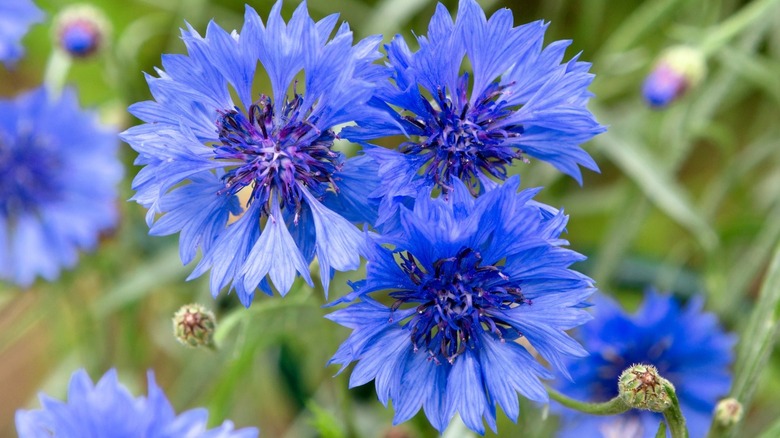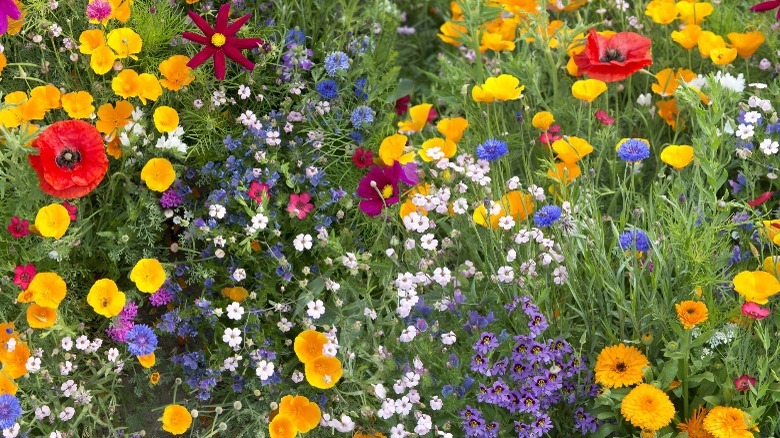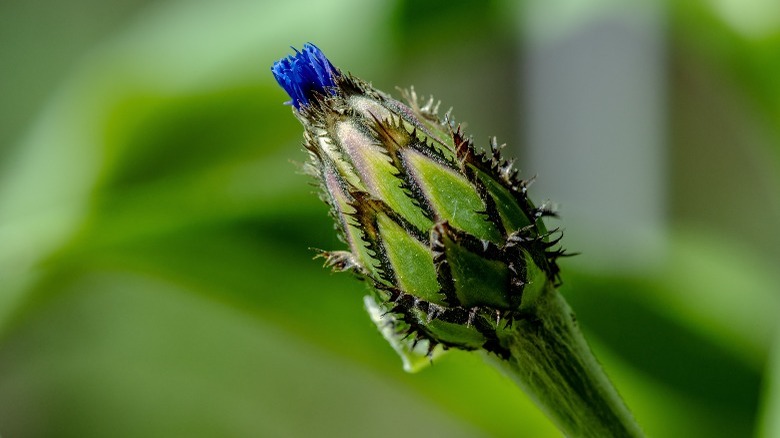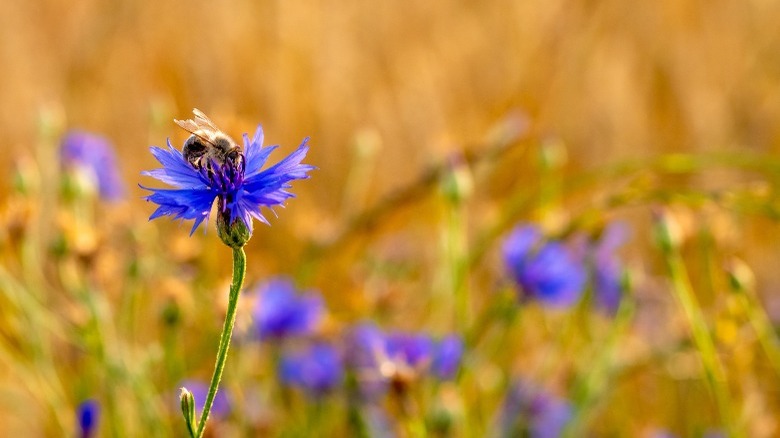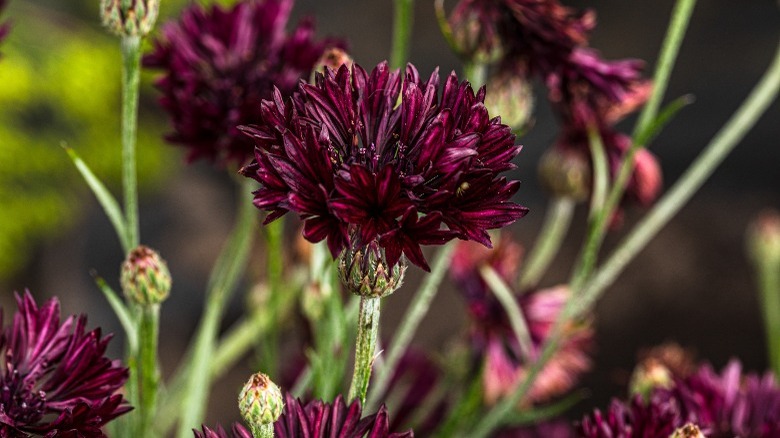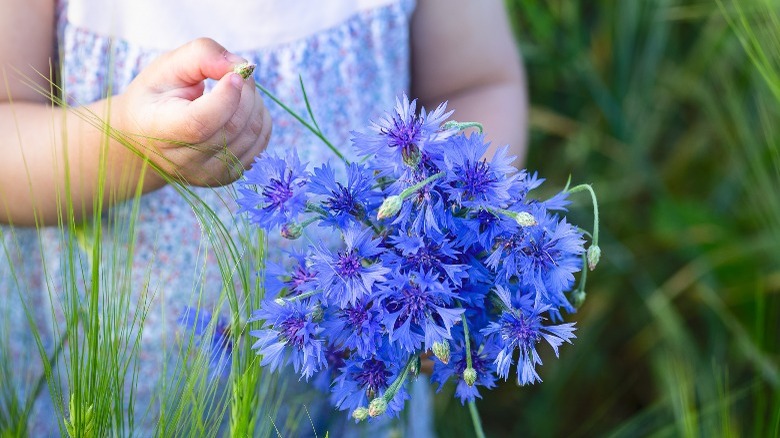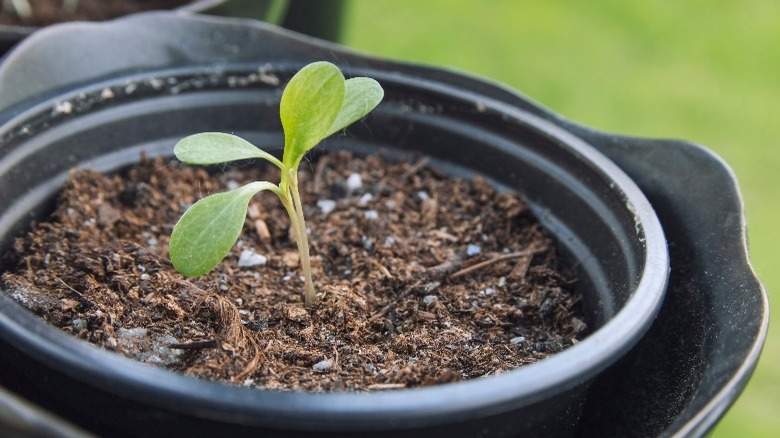How To Successfully Grow Bachelor's Button
Bachelor's button, or Centaura cyanus, is a species of flowering plant with a rich history, a variety of uses, and several more names! The unique moniker derives from an old-fashioned trend in which young men seeking love would wear a single flower on their lapel to signal their interest and availability for courtship, as Epic Gardening explains. If that doesn't sound familiar, you may know the plant as a Cornflower, named for it's tendency to spread wildly and weed-like throughout rural cornfields. Later, this anecdote inspired the name for it's vivid color, termed cornflower blue. According to Saatchi Art, this particular shade was a favorite among accomplished painters such as Johannes Vermeer, who featured the color prominently in his most famous work, "Girl with the Pearl Earring."
No longer considered a weed, bachelor's button has grown in popularity and naturalized in other areas of the world outside of its native Europe. Today, it can be found thriving here in wildflower fields in the U.S., available at seed stores and plant nurseries, and incorporated into all types of garden landscapes. Its more recent popularity is partly due to the same reason the species was considered a nuisance — the plant is incredibly easy to grow, maintain, and spread if left unchecked. The plant is also loved for its whimsical appearance, with wispy petals ranging from bright blue to pale pink and soft blue-green foliage. Keep reading to find out how you can successfully grow bachelor's button yourself!
How to use bachelor's button in garden
Annuals such as bachelors buttons are commonly chosen for short-term use in colder climates, such as seasonal window boxes and containers. You can also use them to add color or fill in sparse areas of your garden. As an edible plant, bachelor's button would not be out of place in your vegetable garden, and their tendency to attract pollinating birds and insects will undoubtedly benefit the surrounding plants, as The Spruce explains. Bachelor's button varieties range in both color and height, including several dwarf species, ensuring you're bound to find something that works for your garden!
The adaptable bachelor's button plant can be used in many ways, but would likely be most at home in a setting resembling their native habitat where they grow in the wild. Though they are annuals, bachelor's button propagate naturally by self-seeding, which allows them to grow and spread season after season. This quality is excellent if you are hoping to plant a wide-reaching wildflower garden, but may not be helpful in other applications, so keep that in mind. If you prefer your garden neat and contained, bachelor's button plants can be easily managed by regular deadheading, or removing spent blooms before they drop and sow seed. According to American Meadows, snapdragons, poppies, and marigolds make excellent companion plants. Their warm sunset shades will contrast beautifully with cornflower blue in your garden, or a cut flower bouquet for you to enjoy indoors as well.
How to grow bachelor's button
Bachelor's button are easy to grow, as they can tolerate a relatively broad range of conditions. The best way to grow bachelor's button is to start them from seed, planted directly in soil. The Spruce explains that bachelor's button are hardy to colder temperatures, and can be planted in the ground in late winter or early spring –- unlike more sensitive species that should be started indoors. They prefer well-drained, loamy soil that leans slightly alkaline, with a pH of 7.2 to 7.8. It's best to avoid planting in excessively moist ground, as that can lead to root rot or fungal infection.
To start planting, use a trowel to dig a shallow row, about 1/2 inch deep. Next, plant the seeds in threes, about 6 inches apart, and cover with soil. You may need to thin the plants later on to maintain enough airflow to keep them healthy. To encourage germination, keep the soil moist until sprouts emerge. It really is that simple, and propagation is even easier.
Bachelor's button are a self-seeding annual, meaning the seeds dropped in the prior season will sprout the next, and you will have flowers consistently growing in the same area, season after season. You may have to monitor their spread, however. According to Epic Gardening, the USDA has listed Centaurea cyanus as invasive in certain regions, and it has become a serious enough problem that the sale of seeds and live plants is banned in North Carolina.
How to care for bachelor's button
As mentioned before, bachelor's button can thrive in a variety of environments, but ideal conditions will produce the best results for both the health and look of your plants. Bachelor's button prefer full sun, which encourages blooms and helps the plants grow strong and upright. While they can tolerate a bit of shade, too much will cause them to flop over, as the blooms are slightly top-heavy. If this does occur, Gardener's World helpfully recommends adding stake supports to help keep the plants upright.
Bachelor button plants require little maintenance throughout their growing season. As long as you water regularly and appropriately for your climate, the plants should have what they need to survive. They do not typically require fertilizer, unless the soil they are growing in is poor and depleted of nutrients. In drier climates, you can add mulch around the base of the plant to retain moisture and hinder the spread of unwanted weeds. There's no need to worry about deer, but you may want to watch out for aphids. Fortunately, Gardener's Path explains that bachelor's button will attract helpful insects that eat aphids, so you may be able to let nature take care of the problem. Bachelor's button do not require deadheading, but it is a good idea to prevent self-seeding, especially if you are worried about spread. You may want to cut the blossoms anyway, either for cut flowers indoors or for culinary use, as is detailed below.
Varieties of bachelor's button
Bachelor's button are native to Europe, but have easily adapted and naturalized throughout the continental United States. Unfortunately, agricultural development and the use of herbicides have endangered the plant in many parts of Europe where it used to grow abundantly, but conservation charity Plantlife emphasizes that there have been some efforts to revive the species. According to Home Stratosphere, the plants vary in height but all stand somewhere between 6 inches to 3 feet tall. Some of the most popular varieties of bachelor button include:
- Blue Boy Bachelor's Buttton (C. cyanus) is named and celebrated for its vivid blue, a color not commonly found in nature. This variant is the best representation of the flower as it is commonly known or appears in pop culture.
- Dwarf Blue Bachelor's Buttton (C. cyanus) is a dwarf variety as its name suggests, growing only 6 to 12 inches tall and blooming from June to September.
- Black Ball Bachelor's Buttton (C. cyanus) is considered a rare variety, coveted for its stunning, deep burgundy color that contrasts beautifully against the blue-green foliage.
- White Ball Bachelor's Buttton (C. cyanus) produces large, white, double flowers that look like whimsical pom-poms, cheerfully reaching 24 inches tall.
Is bachelor's button toxic?
Good news! Bachelor's button are non-toxic and safe for everyone to enjoy both the beauty and utility they can offer. The ASPCA confirms that they are non-toxic to the two most common house pets in the U.S., dogs and cats. They are also non-toxic to humans, and are even recommended as a plant one can use to teach beginning gardening skills to children. Beyond gardening, bachelor's button have a range of uses that may surprise you. For example, their fresh or dried petals can be used to create a natural pigment to dye clothing or yarn.
In fact, bachelor's button are even edible, used for a variety of culinary and medicinal purposes. According to Specialty Produce, cornflowers have a sweetly subdued flavor with notes of black pepper, cucumber, and clove. The subtlety of their flavor gives culinary versatility, and the flowers can be incorporated into a variety of dishes. In addition, the vibrant hue can add exciting color that will elevate your cooking, as blue is less commonly found in nature and in food. Nutritionally, the petals contain vitamin C, calcium, and folic acid, all important in maintaining good health. C. cyanus is also believed to have medicinal benefits. It is most commonly used to make tea, in order to combat issues such as inflammation.
How to repot bachelor's button
Though they can appear wild and unruly when growing in their natural habitat, bachelor's button can be tamed within a planter to create a unique visual effect. Despite their hardy nature, transplanting or repotting is a time when your plant is vulnerable. It's important to know the proper methods to ensure your bachelor's button will not suffer damage during transition. To pot or repot your bachelor's button plant, you'll need a trowel, a container with holes for adequate drainage, and well-draining container soil. Garden soil, by contrast, will retain too much water and increase the chance you'll accidentally drown your plant, or leave it susceptible to root rot or fungal disease.
According to Gardening Know How, the best way to ensure your container plant stays healthy is to make sure it receives plenty of sunlight. This also has the added benefit of encouraging your plant to produce more flowers for you to enjoy. Generally, container plants require a bit more maintenance than those growing in your garden. Because there is less soil surrounding the plant, you'll need to water more frequently, in smaller amounts. In addition, you may need to fertilize your plant with an appropriate mixture about once a month. It is also a good idea to deadhead the plant regularly to continuously encourage new blooms, and keep the plant looking tidy.
